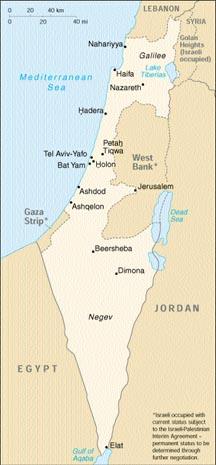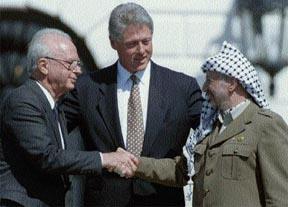
Israeli lands are held as sacred by Jews, Arabs, and Christians alike. Palestine&s history has been marred by often brutal violence. Despite it&s small area, it has been the scene of countless wars and disputes throughout history.
The Arab-Israeli conflict’s roots are deep, and its historical origins are difficult to trace. To understand the current conflict, one must first understand a few essential historical events.The kingdom of Israel was established around 1000 B.C., under the kingship of Saul. They were conquered and exiled for a few generations by the Babylonians, but aside from that period of exile, they remained in the land of Palestine for a millennium. After their third king, Solomon, Israel was divided into two kingdoms. The kingdom in the north was called the Northern Kingdom or Ephraim (named after the largest northern tribe), and the kingdom in the south was called Judah (named after the largest southern tribe). Jerusalem was the capitol of Judah.
The Romans conquered the region in 63 B.C. After a Jewish rebellion in 132 A.D., the Romans renamed the entire region Palestine, which means “land of Philistines,” to humiliate the Jewish people by naming it after their long-vanquished enemy. During Roman occupation, the Jewish temple in Jerusalem was destroyed in 70 A.D. After an abortive rebellion in 132 A.D., the Romans expelled most of the Jews and Christians living in Palestine.
Palestine was conquered circa 640 A.D. by caliph Umar, an Arab Muslim ruler, and in 691 the Arabs built the Dome of the Rock—Islam’s third holiest site in the world—on the site of Israel’s three temples. In 1291, the Mamluks of Egypt, another Muslim group, conquered Palestine. In c.1516, the Turkish Ottoman Empire, which was also Muslim, conquered Palestine. For over a millennium of Muslim rule in Palestine, the Jews generally lived well as a protected minority. This is in stark contrast to the persecution that the European Jews faced during this time.
Toward the end of the nineteenth century, Theodore Herzl began organizing a European Jewish nationalist movement (Zionism) in response to anti-Semitism. At the same time, an Arab nationalist movement was beginning in response to abject poverty that resulted from poor Turkish rule. Leading up to World War I, large numbers of Jews migrated from Europe to Palestine. They paid Arab landholders exceedingly high prices for land in Palestine in order to escape persecution and with the hopes of one day founding a Jewish state in the region. During World War I, both Jews and Arabs fought alongside the British against the Turks.
After the fall of the Ottoman Empire, Jews began to expel Arabs peasants from the land they bought from Arab landholders. The peasants resented this expulsion, and at the same time a resentment of Jewish presence in the Middle East growing among Arab intellectuals. These intellectuals viewed Zionism as an arm of Western Imperialism.
At that time, Great Britain occupied Palestine under a mandate by the League of Nations. In 1917, Great Britain issued the Balfour Declaration, which masterfully promised both the Jews and the Arabs that they alone would receive a state in Palestine. In 1921, over half of the Palestinian land (today’s Kingdom of Jordan) was given to Arabs, and Great Britain still controlled the land west of the Jordan River, which contained both Jewish and Arab settlements. At this time, the resentment between Jews and Arabs was growing increasingly violent.
The rise of Nazism led to an increase of Jewish migration from Europe to Palestine in order to escape the Holocaust. This increased the tension and violence between the two groups even more. In 1947 the UN voted to divide the land of Palestine west of the Jordan into two states, one Jewish and one Arab. In 1948, violence peaked as David Ben-Gurion declared the independence of the state of Israel, and five Arab countries invaded Israel.
Arabs then living amidst the Jews fled during the war for several reasons. Some fled because they feared Jewish retaliation in response to Palestinian massacre of Jewish settlers in Hebron in 1929. Others fled because a group of extremist Jewish fighters massacred an Arab village. Throughout this conflict, even small groups of people that do not necessarily represent the whole of their nations have been able to alter the peace process. Egypt’s radio broadcasts reached many Arabs and advised that they leave the region while the Arab armies eradicated the Jewish presence.
The surrounding Arab nations refused to integrate the refugees because they refused to recognize the legitimacy and permanency of Israel. For its part, Israel refused to allow the refugees to return because they feared more violence. Thus the Palestinian refugee problem began. The refugees subsequently sought to create a national identity for themselves as a tool for survival, as Palestinians and not just Arabs.
Israel fought several more wars, including the Six Day War in 1967, in which Israel captured the West Bank and the Golan Heights from Jordan and Syria. Due to aggressive troop mobilization in several surrounding countries, Israel launched a preemptive strike. Citing indefensible borders (Israel was only 7 miles wide at one point), Israel struck preemptively.
At the end of this conflict, the United Nations created Resolutions 242 and 338, which call for a partial withdrawal of Israeli forces from territories occupied in the war, in order to create two independent and defensible states. Resolution 338 specifies that the future borders of these states will be decided by a treaty between the Israelis and Palestinians. The authors of these resolutions noted that the pre-1967 border was not a viable option in creating two defensible states.
After twenty-six years of sporadic violence, the two parties came to the bargaining table again in 1993, where Israel and the Palestinian Liberation Organization (PLO) negotiated the Oslo Accords, laying out the necessary groundwork for a final peace negotiation. However, the peace process was greatly slowed by acts of violence on both sides. Furthermore, Israeli extremists assassinated Israeli Prime Minister Rabin (who negotiated the Oslo Accords on Israel’s behalf) in 1995.
Then, in 2000, a collapsed peace deal known as the Camp David Talks sparked the violent Palestinian intifada, or uprising, that exists today. Even though the offer Israel made to Palestinian Authority President Yasser Arafat was more generous than any previous offer, Arafat would not accept it. Unlike the previous peace deals, which were stepping-stones to a final negotiation, this deal would have been permanent. After this agreement, the Palestinians would no longer be able to diplomatically pursue any new agreements on the issues of Jerusalem or Palestinian refugees, two issues that are paramount to the Palestinian cause. As a result, the Palestinian Authority orchestrated a violent response to the offer made by Israel and endorsed by President Clinton.
Recently, a new proposal for peace has been made by the Saudis and endorsed by the Arab world. This plan is remarkably similar to the Camp David Talks, however it would reduce Israel to its pre-1967 borders and would cause a massive influx of Palestinian refugees into the Jewish state. The Israelis will not agree to this, because—as the UN noted—the pre-1967 borders would not create two independent and defensible states, and because the number of returning refugees would be so large, that the state of Israel would not be able to handle their return.
Currently, there is no peace plan on the table to which both sides can agree. Unfortunately, negotiators have been unable to find a
viable compromise that satisfactorily addresses the issues of Jerusalem, fair and defensible borders, Palestinian refugees, and the end of terrorism.
As anyone can see, this is a complicated issue, one deeply imbedded in history. It is important for Lawrentians to understand the context for this conflict, so that everyone can make informed and compassionate judgments about the acts taking place in Palestine today.

The 1993 meeting betweem PLO Chairman Yasser Arafat and then Israeli Prime Minister Yitzhak Rabin was one of the few moments of hope for peace. Rabin was assassinated on Nov. 3, 1995, by an Israeli extremist who opposed Israeli concessions made in the peace process.
